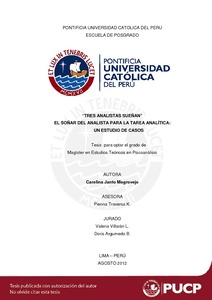| dc.contributor.advisor | Traverso Koroleff, Pierina | |
| dc.contributor.author | Janto Mogrovejo, Carolina | es_ES |
| dc.date.accessioned | 2012-10-05T21:39:01Z | es_ES |
| dc.date.available | 2012-10-05T21:39:01Z | es_ES |
| dc.date.created | 2012 | es_ES |
| dc.date.issued | 2012-10-05 | es_ES |
| dc.identifier.uri | http://hdl.handle.net/20.500.12404/1563 | |
| dc.description.abstract | La presente investigación es un estudio de casos que explora el soñar según W. Bion y su
lugar en la tarea analítica. Para Bion, el soñar es “la forma más profunda de pensamiento”, y se
da tanto de día como de noche. El soñar es la actividad mental que transforma las impresiones
sensoriales de la experiencia emocional en elementos disponibles para pensar, y posibilita así
el crecimiento psíquico (Bion, 1966, 1992). Para esta investigación, tres analistas en formación
registraron en un diario, durante seis meses lo que para ellos constituía “soñar la tarea”
analítica, lo que fue complementado con entrevistas finales y material clínico de sus casos
control. Luego del análisis de los resultados, encontramos tres distintas formas de soñar que
presentamos detalladamente y constituyen el centro de nuestro estudio, así como algunas
características en común, relacionadas a su condición de analistas en formación. Si bien el
soñar como actividad mental se encontró presente en los resultados de los analistas, este se
encuentra, al mismo tiempo, en desarrollo. Para finalizar, planteamos la necesidad de dar
cuidado constante al “laboratorio de sueños” que es la mente del analista, para que pueda
seguir soñando. | es_ES |
| dc.description.abstract | The present research is a case study that explores dreaming as proposed by W. Bion, and its
place in the analytic work. According to Bion, dreaming is “the most profound form of thinking”,
and occurs by day as well as by night. Dreaming is the mental activity that transforms sensorial
impressions of emotional experience into thinkables elements, and so doing permits psychic
growth (Bion, 1966, 1992). For this research, three training analysts registered in a diary during
six months their dream thoughts about their analytic work. This was complemented with final
interviews, and some clinical material about their control cases. After the data analysis, we
found three different ways of dreaming, wich are described with detail and contitutes the core of
our study, but also we found similar characteristics related to their condition of being training
analysts. Even though dreaming as a mental activity is present in the analysts’ collected data,
it’s still evolving. Finally, we suggest the need for constant care in the “dreaming laboratory” that
analyst’s mind contitutes, to preserve his capacity to dream. | es_ES |
| dc.language.iso | spa | es_ES |
| dc.publisher | Pontificia Universidad Católica del Perú | es_ES |
| dc.rights | info:eu-repo/semantics/openAccess | es_ES |
| dc.rights.uri | http://creativecommons.org/licenses/by-nc-nd/2.5/pe/ | * |
| dc.subject | Bion, Wilfred R. (Wilfred Ruprecht), 1897-1979 | es_ES |
| dc.subject | Sueños | es_ES |
| dc.subject | Psicoanalistas | es_ES |
| dc.title | "Tres analistas sueñan" : el soñar del analista para la tarea analítica | es_ES |
| dc.type | info:eu-repo/semantics/masterThesis | es_ES |
| thesis.degree.name | Maestro en Estudios Teóricos en Psicoanálisis | es_ES |
| thesis.degree.level | Maestría | es_ES |
| thesis.degree.grantor | Pontificia Universidad Católica del Perú. Escuela de Posgrado | es_ES |
| thesis.degree.discipline | Estudios Teóricos en Psicoanálisis | es_ES |
| renati.discipline | 313107 | es_ES |
| renati.level | https://purl.org/pe-repo/renati/level#maestro | es_ES |
| renati.type | http://purl.org/pe-repo/renati/type#tesis | es_ES |
| dc.publisher.country | PE | es_ES |
| dc.subject.ocde | https://purl.org/pe-repo/ocde/ford#5.01.00 | es_ES |






